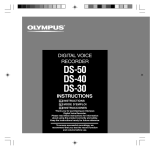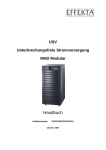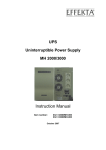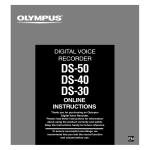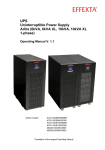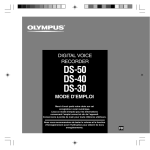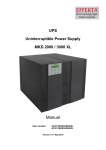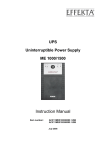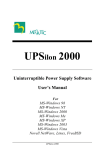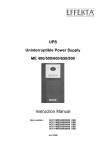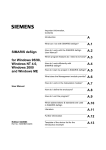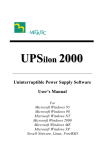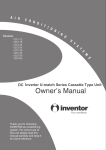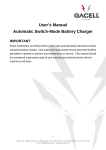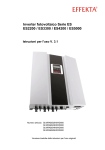Download Instruction Manual
Transcript
UPS Uninterruptible Power Supply MHD Modular Instruction Manual Item number: ACR11ENSXXK00XXX Oktober 2006 MHD Modular UPS Instruction Manual Contents MHD series 1 Presentation 4 2 2.1 Warranty conditions Limitation of liability 5 6 3 3.1 3.2 3.3 3.4 3.5 3.6 3.7 Safety General safety instructions Transportation and storage Setup Connection Operation Handling batteries Maintenance, servicing and faults 7 7 7 8 9 9 10 10 4 Introduction 11 5 System description 12 6 6.1 6.2 6.3 Description of equipment – MHD Modular Equipment elements on the front panel Equipment elements on the rear panel Audible alarm signals of the UPS 14 14 17 19 7 7.1 7.2 Storage and unpacking Storing the UPS Unpacking the UPS housing 19 19 20 8 8.1 8.2 8.3 8.4 8.5 8.6 Installing and connecting the UPS Setup and assembly of the UPS Replacing the power modules Connecting the UPS Communications connection of UPS SNMP adapter (optional, Intelligent Slot) Connection sequence 21 21 24 25 28 29 29 9 9.1 9.2 9.3 9.4 9.5 9.6 9.7 9.8 Operation Operating modes and signals Switching on the UPS Starting the UPS Switching off the UPS Setup Connecting the internal bypass Switching off internal bypass Telephone queries 30 30 32 33 34 35 37 38 38 10 Starting up the UPS equipment 39 11 Troubleshooting 39 Page 2 of 49 MHD Modular UPS MHD series Instruction Manual 12 Software 41 13 13.1 13.2 13.3 13.4 13.5 13.6 Maintenance and servicing Activating maintenance bypass (interruption-free) Deactivating maintenance bypass (interruption-free) Measuring the bridging time (support time) Service log Service hotline Maintenance and service contracts 42 42 43 44 45 46 46 14 14.1 14.2 14.3 Technical Data Equipment specifications Accessories List of wearing parts 47 47 48 49 15 Requirements for the declaration of conformity 49 Page 3 of 49 MHD Modular UPS Instruction Manual 1 Presentation In this instruction manual, the abbreviation UPS stands for Uninterruptible Power Supply. The following pictograms are used in this instruction manual: Denotes information which, if disregarded, poses a risk to health, functionality or safety. Warning about the handling of batteries. Warning about dangerous electrical voltage. Denotes additional information and tips. Recycling symbol. Denotes components that are governed by the electronic scrap ordinance. Denotes components or parts that must be disposed of in a specific manner. Never throw these components into the regular refuse. Copyright © 2006 All rights reserved. This instruction manual is protected by copyright law. The copyright owner is EFFEKTA Regeltechnik GmbH. Trademarks: All trademarks used are the property of their respective owners. EFFEKTA® is a registered trademark of EFFEKTA Regeltechnik GmbH. We reserve the right to make technical and visual changes, and we are not liable for typographical errors. MHD series Page 4 of 49 MHD Modular UPS Instruction Manual 2 Warranty conditions The delivery receipt is considered to be the initial proof of purchase and should be stored carefully. It is required for all warranty claims. If the product is transferred to another user, then the latter is entitled to claim under the warranty for the remainder of the warranty period. The purchase receipt and this declaration should be transferred to the possession of the new owner. We guarantee that this equipment is in a functional state and corresponds in technical terms to the descriptions in the enclosed documentation. The warranty period for the equipment corresponds to the minimum period prescribed by legislation. This warranty is not valid for the following cases: o Defects due to: damage during transportation, accidents, natural disasters, misuse, vandalism, inappropriate use, maintenance errors or incorrect repairs by third parties. o Modifications, unauthorised tampering, incorrect operation, another device or accessory, incorrect installation, or any modification not approved by us. o Disregard for the instructions in the supplied documentation. o Incompatibility of the product as a result of technical innovations or regulations that may come into effect after the purchase. o Incompatibility or malfunction caused by product components not used by us. o Signs associated with the normal ageing process of the product (wearing parts). o Defects caused by external appliances. The warranty period for parts replaced and/or repaired within the scope of this warranty expires with the original warranty for the product. Equipment sent in without accessories will be replaced without accessories. Equipment returned will only be accepted if it is returned in the original packaging. All incidental transportation costs are excluded from the provisions of the warranty. MHD series Page 5 of 49 MHD Modular UPS Instruction Manual EFFEKTA GmbH does not give any express or implied warranties in relation to this equipment and its quality, performance, merchantability or suitability for a specific purpose. In some countries, the exclusion of implied warranties is not permitted by law. In this case, the validity of all express and implied warranties is restricted to the warranty period. When this period expires, all warranties cease to be valid. In some countries, a limitation of the validity period of implied warranties is not permitted by law, in which case the above restriction is not effective. 2.1 Limitation of liability Compensation claims are excluded unless they are based on deliberate acts or gross negligence of EFFEKTA GmbH or its employees. Liability under the Product Liability Act remains unaffected. Under no circumstances will we be held liable for: o Claims for losses or damage made by third parties against you. o Loss of or damage to your records or data or the cost of their recovery. o Financial consequential damage (including loss of earnings or savings) or incidental damage, even in the event that we were informed of the possibility of such damage. Under no circumstances whatsoever will EFFEKTA GmbH be held responsible for any coincidental, indirect, special, consequential or other damage of any kind (including, without limitation, damage relating to loss of profit, discontinuation of business, loss of business information or any other loss) arising from use of the equipment or in any connection with the equipment, whether based on a contract, compensation, negligence, strict liability, or other claims, even if EFFEKTA GmbH was informed in advance about the possibility of such damage. This exclusion also applies for any liability arising from claims of third parties against the initial purchaser. In some countries, the exclusion or limitation of coincidental or consequential damage is not legally permitted, in which case the above declaration is not effective. MHD series Page 6 of 49 MHD Modular UPS Instruction Manual 3 Safety 3.1 General safety instructions This instruction manual contains important safety instructions. Read and observe the user manual and safety instructions in this chapter before taking any further action (transportation, storage, connection, startup etc.). Heed all warnings and follow all working instructions both on the unit and in this instruction manual. Since the UPS equipment uses mains voltage and has a corresponding energy accumulator (high-capacity batteries) installed external to the device, the instructions in this chapter are very important for all users and personnel. Safety information on batteries and battery packs is therefore also provided here. When using external battery packs, you must also follow the safety instructions in the accompanying instruction manual. Work on the UPS equipment may only be performed by authorised technical personnel. 3.2 Transportation and storage The UPS may only be transported to its place of intended use in the original packaging. The same applies for removals or returns. The equipment may only be transported or stored in an upright vertical position. Position the equipment securely during transportation, taking its centre of gravity into account. Due to its weight, UPS equipment may drop suddenly if its position shifts slightly. When storing equipment, make sure that it is also securely positioned. MHD series Page 7 of 49 MHD Modular UPS Instruction Manual 3.3 Setup The UPS is intended for use in ventilated rooms. The operating temperature range for the UPS is between 0°C and 40°C. The ideal room temperature should not exceed 25°C. The heat lost by the UPS is expelled via internal fans and released into the surrounding air. If required, this heat should be removed from the UPS room via an appropriate cooling or air-conditioning system (forced cooling). During installation, the installation location prescribed by the manufacturer must be observed. The only permitted installation position for the unit is the upright vertical position. There is a risk of condensation where the UPS is exposed to extreme and rapid temperature changes. Before taking any further steps, the equipment should be allowed to acclimatise for at least 2 hours. Never set up or operate the equipment in a damp environment. Keep fluids away from the equipment. The unit must not be installed or operated in environments with flammable gases or aggressive (caustic) media. The UPS must not be set up near heat sources. Ensure that the unit’s vents are not obstructed and that air can circulate freely. In view of the weight of the UPS (see technical data), the floor of the room where the unit is to be installed must have sufficient load-bearing capacity. If in doubt, contact the building contractor. The room must have sufficient clearance for the installation. The door dimensions and transit routes must provide sufficient clearance for transporting the unit. When transporting the unit, use suitable transportation aids with sufficient lifting power. There must be sufficient clearance around the unit for installation and maintenance tasks. MHD series Page 8 of 49 MHD Modular UPS Instruction Manual 3.4 Connection Protective earthing Before connecting the supply cable, the protective earth must be connected. The unit must not be operated without protective earthing. Installation This unit must be installed by qualified specialist personnel. Only a VDE-tested and CE-labelled mains cable may be used to connect the UPS to the house installation. Only use VDE-tested and CE-labelled electrical cables to connect the consumer load to the UPS. Do not connect any consumer loads that could overload the equipment (such as electric motors) to the UPS. Keep the connecting cables as short as possible and always lay these correctly. Avoid the dangers of laying connecting cables in locations where they may be tripped over, crushed or torn open etc. RCD This device exhibits a high degree of stray current in the direction of protective earth. The maximum stray current is 300mA. This additional residual current rate must be taken into consideration along with the load rate when setting up an upstream RCD (we recommend the installation of a device for up to 500mA stray current). In the event of a fire Dangerous voltages are present inside UPS, even when the fuses have tripped! For this reason DO NOT USE WATER if the unit catches fire. Staff training All staff must be trained in activating the emergency cutout. To effect an emergency cutout, switch off the main fuse in the mains power input (rear side of the UPS) and the battery fuse (battery cabinet or external battery connection unit). 3.5 Operation The mains power cable must never be disconnected during the operation of the UPS, otherwise the protective earthing of the UPS and the connected consumer loads may be lost. The UPS equipment contains an energy accumulator (batteries). This means that the output of the UPS may be live even if it is not connected on the line side. Do not attempt to open the UPS housing whilst the unit is in operation. There is the risk of an electric shock. MHD series Page 9 of 49 MHD Modular UPS Instruction Manual 3.6 Handling batteries Warning – danger of electric shocks and burns. Batteries can cause electric shocks and are capable of producing high shortcircuit currents which can also inflict burns. Unauthorised persons must be kept away from batteries. Do not place batteries against heat sources and do not throw them into a fire as they might explode! Do not open or destroy batteries. The electrolyte released is extremely dangerous to persons and to the environment (danger of chemical burns to skin and eyes, toxic). Defective batteries must be disposed of in an environmentally friendly manner. Never throw batteries into the regular refuse. The local waste disposal regulations must be observed. 3.7 Maintenance, servicing and faults Warning – danger of electric shocks. The UPS remains connected to the battery circuit even after it has been disconnected from the mains power supply and has a dangerous voltage potential. Therefore always disconnect the battery circuit before carrying out servicing or maintenance work and make sure that the equipment is isolated from the supply. Work on batteries may only be performed and monitored by personnel with appropriate technical knowledge about the required precautions. Unauthorised persons must be kept away from batteries. When working on the UPS, the following precautions must be taken: o Remove wristwatches, rings and other metallic objects o Only use electrically-insulated tools The UPS must not be dismantled. MHD series Page 10 of 49 MHD Modular UPS Instruction Manual 4 Introduction This manual is intended to provide basic information on single- or three-phase online UPS equipment, including the functional principle, how the various functions may be applied and troubleshooting. In addition, this manual contains information on transportation and storage as well as handling and installation of the UPS equipment. The planning guidelines in this manual relate only to the specific requirements for UPS equipment. The national and local regulations for electrical installations must be followed without fail during installation. The contents of the description for this equipment may change as a result of technological developments. Though we have endeavoured to make these contents as accurate and clear as possible, we would be grateful for information on any errors which are noted. We accept no liability for errors in this description or their consequences. The purpose of UPS (Uninterruptible Power Supply) equipment is to protect sensitive electrical devices such as computers, workstations, electronic points of sale, mission-critical instruments, telecommunications equipment, process controls etc. from faults which may arise as a result of poor power supply quality or even power failures. Sensitive devices such as these require comprehensive protection against electrical faults. These may be external faults (e.g. bad weather, operating faults) or faults caused by adjacent devices (e.g. motors, air conditioning units, processing machines, welding equipment etc.). The power supply faults may be summarised as follows: o Fast and slow voltage spikes and fluctuations; o Mains power failure; o Fast and slow frequency spikes and fluctuations; o Mains heterodyning or transient voltages The UPS equipment prepares the mains voltage and ensures that the voltage values at the output to the consumer load remain constant. Faults in the mains voltage are thus prevented from reaching mission-critical devices and therefore cannot cause any damage to software and hardware, data loss or operating faults. MHD series Page 11 of 49 MHD Modular UPS Instruction Manual 5 System description The UPS operates continuously in accordance with the double converter principle. It prepares the line current and delivers an uninterrupted and faultfree single-phase voltage to mission-critical consumer loads. The UPS can be powered via both a single- and three-phase input voltage. The UPS consists of several power modules, each independent of the others, that can be connected together to produce a parallel redundant UPS system. In normal mode the load is distributed equally across the individual integrated modules. If a module fails, the remaining modules bear the load and enable the defective module to be replaced whilst the UPS is in operation. This is of course only possible if a corresponding reservoir of power is available via at least one additional redundant module. In addition to supplying consumer loads, the equipment also keeps its internal batteries in a fully charged state. In the event of a mains power failure or fault, the UPS continues to deliver a clean uninterrupted voltage supply to the UPS output. Energy is drawn from the batteries in support mode. Fig. 1: Block diagram of power module The block circuit diagram shows the individual components in the power module and provides an illustration of how they interact. If the mains power failure exceeds the bridging time of the UPS, it shuts down to prevent deep discharging of the batteries. When the mains power supply is restored, the UPS restarts automatically, supplies the consumer loads and monitors the charging of the battery pack. MHD series Page 12 of 49 MHD Modular UPS Instruction Manual Key performance features of the MHD Modular on-line UPS include: MHD series o Absolutely no interruption or signal modification in the event of a primary mains power supply failure; o Perfect sine voltage at the UPS output – Greatly enhanced quality of output voltage compared to the mains voltage of the house network; o High availability due to the fact that a parallel redundant system can be implemented; o Individual power modules can be replaced without interrupting operation of the UPS (hot-swap); o Possibility of retrospectively increasing the power output of the entire system; o Processor-controlled bypass mode; o Input-side “power factor” correction (>0.95); o High efficiency up to 89%; o High-performance communications interface (RS232 interface); o LCD display for displaying status and operating data. Page 13 of 49 MHD Modular UPS Instruction Manual 6 Description of equipment – MHD Modular In this chapter you will be introduced to the various elements of the equipment and will be provided with instructions on its operation as well as all information on equipment connections. 6.1 Equipment elements on the front panel Fig. 2: Front view MHD Modular All of the operator control and display elements required for normal operation are positioned on the front of the equipment. MHD series Page 14 of 49 MHD Modular UPS Instruction Manual a) Control and display panel The control panel consists of three control and display units. These are: o LED indicators (left side) o LCD display (centre) o Keypad (right side) The LED indicators enable a quick display of the system and operating status. This information may be displayed again in the LCD display. The following LED indicators are possible: o Normal: The unit is working within valid operating parameters. No faults have been detected. o On Battery: The unit is operating in support mode, the mains power has failed or is outside valid specifications. o Bypass: The unit is operating in internal bypass mode. The input phase “R” is connected directly to the output. The output is not being supplied by the inverter. o Fault: The unit has detected a fault (e.g. overload, mains power failure). The LCD display enables a detailed display of status values and operating parameters. MHD series Page 15 of 49 MHD Modular UPS Instruction Manual The keypad is used for controlling and parameterising the UPS. The following key functions have been implemented: o ESC: Cancels an entry or function. Exits a display level and returns to the next one up. o Scroll up (up arrow): Increases a value or changes the selection of a value (always confirm via ENTER). o Scroll down (down arrow): Reduces a value or changes the selection of a value (always confirm via ENTER). o ENTER: Confirms a change or selection. b) System “on” switch: (Located behind the control-panel cover) Activate this switch to switch the system on. The switch does not need to be activated in normal mode. c) Slots for power modules: Power modules (6 pcs.) can be inserted into the slots by removing the covers. No tools are required for inserting the modules. MHD series Page 16 of 49 MHD Modular UPS Instruction Manual 6.2 Equipment elements on the rear panel Fig. 3: Rear view MHD Modular Danger! All connections on the rear panel (with the exception of the RS232/485 interface, Intelligent Slot) are at mains power potential when connected. Even when disconnected, dangerously high voltages may be present at the plug connections as a result of charged capacities inside the equipment. a) Terminal panel: The terminal panel is used for the unit’s power connections. These connections are: MHD series o Mains power input (single- or three-phase) o Power output (single-phase) o Battery pack (120V DC rated) Page 17 of 49 MHD Modular UPS Instruction Manual The protective earth conductor must always be connected! Please always observe the input voltage shown on the identification label or in the technical data of this manual. b) Mains power input switch The cover of the power switch can be removed without tools. c) Communication (9-pin D-Sub jack) All relevant UPS data are transmitted to an appropriate primary control unit (e.g. PC) via the serial interface. d) Intelligent Slot The pre-prepared slot enables communication modules to be added to the unit, e.g. SNMP adapter, AS 400 interface. e) Maintenance bypass power switch This switch is only used for maintenance tasks. The switchover may only occur if the system has already been switched electronically to internal bypass mode. f) Fuse output The fuse is used for fusing the UPS output. The cover of the maintenance bypass switch and the output fuse is mechanically secured. When the cover is removed, the unit is automatically switched to internal bypass mode. This means that the load is no longer protected against mains power failure. Identification MHD series The identification label contains information about the: # Manufacturer # Equipment model and output class # Equipment input values # Equipment output values # Item number # Serial number # CE and barcode designation Page 18 of 49 MHD Modular UPS Instruction Manual 6.3 Audible alarm signals of the UPS Bypass mode: The audible alarm sounds in the following sequence (A) [beep -> long pause (2 min) -> beep -> ..., repeating]. Support mode and high battery capacity: The audible alarm sounds in the following sequence (B) [beep -> long pause (4 sec) -> beep -> ..., repeating]. Support mode and low battery capacity: The audible alarm sounds in the following sequence (C) [beep -> short pause (2 sec) -> beep -> ..., repeating]. Operating fault or overload: The audible alarm sounds with a continuous tone, sequence (D) [Beeeeeeeeeeeee....p]. 7 Storage and unpacking 7.1 Storing the UPS If the equipment is not installed immediately, the following should be observed: MHD series o The equipment and accessories must always be left in the original packaging and stored. o The recommended ambient storage temperatures are: +5°C...+30°C. o Protect the equipment and its packaging from moisture. Page 19 of 49 MHD Modular UPS Instruction Manual 7.2 Unpacking the UPS housing When unpacking, ensure that the unit is in the upright position. Check the shipping note to make sure that the delivery is complete. If the delivery is incomplete or incorrect, inform the supplier immediately. You should also check the delivery for transit damage. Any claims for transit damage must be made immediately: o Retain the all shipping cartons and packaging material for verification purposes. o Immediately inform the manufacturer or your supplier. o Immediately inform the shipping company. Unpack the UPS as follows: o Remove the packing straps and lift the packing carton upwards. (Fig. 1) o Remove the packing feet around the housing. (Fig. 2) o Remove the plastic film. o Using a suitable lifting device, lift the unit off the pallet and position it at the intended installation location. (Fig. 3) Fig. 4: Unpacking the UPS Fig. 1 MHD series Fig. 2 Fig. 3 Page 20 of 49 MHD Modular UPS Instruction Manual 8 Installing and connecting the UPS Warning A dangerously high battery voltage is present in the unit even when the mains power is switched off! For this reason, all connection and commissioning tasks must be performed by a qualified electrician. The electrician must familiarise himself with the special conditions present in this UPS series by reading the instruction manual and the installation instructions. All requirements in the technical data regarding environmental and operating conditions must be observed to ensure trouble-free functioning of the UPS. 8.1 Setup and assembly of the UPS The following must be observed when setting up / installing the UPS equipment: Fig. 5: Performance reduction MHD series o Install the UPS in a stable environment free of vibrations, dirt, high levels of humidity, flammable gases and aggressive (caustic) substances. o Avoid extremes of temperature and atmospheric humidity. A maximum service life, particularly in relation to the batteries, is achieved at an ambient temperature of 15-25°C. o Observe the specified installation position. The specified installation position for the unit is the upright vertical position only. o The UPS functions within the specified limits up to an installation altitude of 1000m with no limitations. Above an installation altitude of 1000m, the overall load must be reduced to the following values. Installation altitude [m] 1000 1500 2000 2500 3000 3500 4000 4500 5000 Performance reduction 100% 95% 91% 86% 82% 78% 74% 70% 67% Page 21 of 49 MHD Modular UPS Instruction Manual o Always ensure that sufficient space is available behind the UPS to perform the necessary connections. The load-bearing capacity of the support must be sufficient. o Make sure that ventilation of the equipment is possible at all times. Air is drawn in from the front and blown out at the rear. For this reason the following minimum clearances to the UPS must be observed: - min. 80cm to the front of the unit - min. 30cm to the rear of the unit Ensure that an appropriate flow channel exists. o Make sure the equipment is arranged correctly. When installed in parent systems (e.g. electrical service room), ensure that the UPS operates within the specified temperature range. A sufficient level of forced ventilation must exist to remove excess heat that builds up in the space where the UPS is installed. Proceed in accordance with the following steps and figures when assembling the individual modules of the UPS: o Position the unit at the installation location and secure it by lowering the mounting bases (Fig. 1) o Push the communication module into the upper left slot (Fig. 2) o Push the additional charger (optional) into the upper right slot (Fig. 3) Fig. 6: Installation and assembly of the communication unit and charger Fig. 1 o MHD series Fig. 2 Fig. 3 Push each power module into the slots provided, starting at the bottom and working up. When doing so, ensure that the previous module is properly installed before installing the next one. (Fig. 4-6) When a module is properly installed, it clicks into place. No further fixing in the slot is required. Page 22 of 49 MHD Modular UPS Instruction Manual Fig. 7: Fitting the power modules Fig. 4 Fig. 5 Fig. 6 o Affix the plastic covers in front of the slots for the power modules from bottom to top. o Connect the LCD module to the communication module, secure the plug of the connecting cable with the screws supplied and affix the LCD module to the UPS. (Fig. 7) Fig. 8: Fitting the display unit and front covers Fig. 7 MHD series Page 23 of 49 MHD Modular UPS Instruction Manual 8.2 Replacing the power modules To replace power modules, or to add additional modules, proceed as follows. o Remove the plastic cover from the slot in question. o Pull the corresponding module out of the slot via the gripping hollow. (only when exchanging) o Push the new module into the free slot until you feel the catches click into place in the gripping hollows. o Affix the plastic cover over the open slot. The modules can be exchanged or installed at any time during the operation of the UPS. The UPS automatically recognises the installed modules. Warning Ensure that the remaining modules are not overloaded when a module is removed. When installing new modules, ensure that the electrical installation is configured to increase the load. MHD series Page 24 of 49 MHD Modular UPS Instruction Manual 8.3 Connecting the UPS The models of the MHD Modular series are equipped with screw terminals. The connection diagram and the following information must be observed. The terminal panel is located on the rear of the UPS unit. To connect the cables, remove the protective cover by releasing the retaining screws. Fig. 9: Terminal panel of the UPS Warning The UPS equipment contains components with high voltage and amperage. Incorrect handling may therefore result in electrical accidents which may have fatal consequences or cause material damage. The UPS unit can be connected with single- or three-phase current. The following diagrams show the correct connection of the unit: MHD series Page 25 of 49 MHD Modular UPS Instruction Manual Fig. 10: Singlephase connection diagram The protective earth conductor must always be connected! If not, the consumer loads will not be earthed. In the case of single-phase connections, the external conductor must be connected to terminal “R” on the UPS. Connecting this to inputs “S” or “T”, may damage the UPS and cause the internal bypass to malfunction. Fig. 11: Threephase connection diagram The protective earth conductor must always be connected! If not, the consumer loads will not be earthed. MHD series Page 26 of 49 MHD Modular UPS Instruction Manual When using a three-phase connection, ensure a clockwise phase sequence. If the phase sequence is incorrect, the UPS does not start and a warning signal sounds. Additionally the message “phase sequence error” appears on the LCD display. Warning The connection diagrams shown here are only valid if: o the loop resistance is complied with up to the last consumer load; o the earthing of the consumer loads is ensured; o or that the consumer loads are separately protected against overcurrents and residual currents, and are also earthed. Please note that if the UPS equipment is in an emergency OFF circuit and this is activated, power will still be supplied to the UPS output. The consumer loads will continue to be supplied for the duration of the support time. Warning! The mains power supply must be protected with fuses between the mains power supply and the UPS. The use of RCDs within the power supply of the UPS unit is not advisable. The leakage current that result from the RFI filters can cause a false alarm for the protective measures. RCDs that comply with EN50091-1 with adjustable tripping values can be used to cater for the leakage current of the UPS. The following table shows fuses and cable cross-sectional areas to be used to connect the UPS. An ampacity in compliance with part 523 of DIN VDE 0100 at an ambient temperature of 30°C was assumed for the cables. The cable cross-sectional areas and fuses in three-phase operation also provide for the UPS to be operated with a full load and active bypass. Here input “R” is subjected to a full load current, identical to single-phase operation. The appropriate cable diameters and fuses must be determined for each case, taking into account the ambient temperature, the cable bundling and the cable lengths in accordance with VDE and local provisions. The cable cross-sectional areas listed do not specify the necessary diameter of the protective earth conductor. The protective earth conductors with the corresponding diameters must be dimensioned in accordance with part 540 of VDE 0100. MHD series Page 27 of 49 MHD Modular UPS Fig. 12: Cable dimensioning and fusing Instruction Manual 4 Power [kVA] 8 12 16 20 24 Input phases 1 3 1 3 1 3 1 Input fuse [A] 1 x 63 3 x 63 1 x 63 3 x 63 1 x 80 3 x 80 1 x 80 3 x 80 1 x 100 3 x 100 1 x 125 3 x 125 Min. cable crosssectional area at input [mm²] 2 x 16 4 x 16 2 x 16 4 x 16 2 x 25 4 x 25 2 x 25 4 x 25 Min. cable crosssectional area at output [mm²] Battery pack fuse [A] Min. cable crosssectional area at battery pack [mm²] 3 1 3 2 x 35 4 x 35 1 3 2 x 35 4 x 35 2 x 16 2 x 16 2 x 25 2 x25 2 x 35 2 x 35 40 80 125 160 200 250 2 x 16 2 x 25 2 x 25 2 x 35 2 x 50 2 x 70 Warning If the unit is to be fully expandable, the fuses and cable cross-sectional areas must be selected in accordance with the maximum expansion level. The fuses and cable cross-sectional areas must always be checked when expanding the unit. 8.4 Communications connection of UPS A convenient communications interface is available that facilitates data exchange with the UPS. The connection should only be made using the cables specified in the “Accessories” chapter. If an SNMP adapter is used, the communications interface is switched off. Fig. 13: UPS internal wiring of communication interface Pin: Assignment: 2 RS232 Transmit data (Tx) 3 RS232 Receive data Rx 5 RS232 GND The communications interface is completely galvanically isolated. MHD series Page 28 of 49 MHD Modular UPS Instruction Manual 8.5 SNMP adapter (optional, Intelligent Slot) The integrated SNMP adapter is used for data exchange between the UPS and a computer network. Both signal and control functions are possible. For the description of the SNMP adapter necessary for the equipment connection, consult the “UPS SNMP ADAPTER” manual supplied. 8.6 Connection sequence Connect the UPS to the mains making sure that the mains and UPS are safely switched off beforehand. Check the phase sequence (three-phase connection) and the connection voltage of the mains power. Connect the consumer load(s) to the UPS. Ensure that all consumer loads are switched off. Connect the battery pack to the UPS. Check the polarity and the voltage of the battery pack. MHD series Page 29 of 49 MHD Modular UPS Instruction Manual 9 Operation 9.1 Operating modes and signals Operating Audible Fault Bypass Normal conditions On Battery LED display alarm LCD display Comment Sequence Normal mode Mains voltage is normal off Battery mode Mains voltage outside specified limits B Supply voltage is abnormal C Battery voltage is too low. Reduce load A Mains voltage is too high B Mains voltage is too low B Battery voltage abnormal Bypass mode Mains voltage is normal Alarm is switched off on switch to normal mode Supply voltage is abnormal, output is switched off Supply voltage is abnormal, output is switched off Warning: UPS is not connected to battery pack Bypass mode Normal mode MHD series C UPS is not connected to battery pack B UPS is not connected to battery pack Check that the safety cutoff for the battery pack is closed Check that the safety cutoff for the battery pack is closed Page 30 of 49 MHD Modular UPS Operating conditions Instruction Manual Fault Bypass On Battery Normal LED display Audible alarm LCD display Comment Displays phase error, output switched off, UPS switches off after 30 seconds. Check network connection of UPS Sequence Phase or phase-sequence error Phase error (bypass mode) Device error (normal mode) Phasesequence error C B Device error Alarm code: 02 03 09 C Displays device and phase error, output switched off, UPS switches off after 30 seconds. C Output overload D Displays error code 46 Check network connection of UPS Overload protection Overload warning (normal mode) Switch-off overload (normal mode) Overload warning (battery mode) Switch-off overload (battery mode) Overload warning (bypass mode) Key: MHD series C Output overload D Displays error code 46 C Output overload LED flashes LED lights continuously Reduce connected load Reduce connected load Reduce connected load Reduce connected load Reduce connected load Page 31 of 49 MHD Modular UPS Instruction Manual 9.2 Switching on the UPS Warning Before switching the UPS on, the unit must be correctly installed and the installation checked. This mainly involves input voltage, phase sequence and battery voltage and polarity. The UPS equipment contains components with high voltage and amperage. Incorrect handling may therefore result in electrical accidents which may have fatal consequences or cause material damage. The following sequence must be observed when switching on the UPS: o Connect battery voltage (external switch or fuse on the battery pack) o Switch on the mains isolator switch (reverse of UPS, start fan) o Activate the system switch on the rear of the control-panel cover. The following steps are then performed via the control panel: E1: Automatic display of UPS self-test. Switches automatically to E2. MHDMODUL UPS UPS SELF TESTING PLEASE WAIT A MOMENT E2: Press “ESC” ->UPS ON SETUP INQUIRE E3: LOAD: 0% BATT: 137 I/P VOLT:220 220 221 O/P VOLT: 0 O/P FREQ:50.0Hz STATUS: NO OUTPUT Overview of all operating data and parameters. Select displays via “Scroll up” and “Scroll down” keys. Continue as per E4-E8 E4: Displays output parameters OUTPUT PARAMETER RN SN TN VOLT: 0V CURR: 0A FREQ: 0.0Hz All parameters equal “0” as the output is still switched off. MHD series Page 32 of 49 MHD Modular UPS E5: Instruction Manual Displays input parameters INPUT PARAMETER RN SN TN VOLT: 220V 220V 221V Freq:50.0Hz RST INPUT E6: Displays power parameters POWER PARAMETER kW kVA TOTAL: 0.00 0.00 UPS 1 0.00 0.00 UPS 2 0.00 0.00 The total power and the power of the individual power modules is displayed. The display of the power modules toggles in lines 4 and 5. E7: Displays battery parameters BATTERY PARAMETER BAT VOLT:137V VOLUME : 100% STATUS : CHARGING E8: OTHER PARAMETER MODEL :MHDMODUL UPS SERIAL: XXXXXXXXXXX VERSION: XXXXXXXXXXX Displays serial number and the version status of the UPS unit The displays can be used to evaluate the current parameters. These should be checked before starting the UPS (output connection) and any faults should be remedied before further switching operations. 9.3 Starting the UPS Before starting the UPS, the unit must be switched on. The following sequence must then be observed when starting the UPS: S1: LOAD: 0% BATT: 137 I/P VOLT:220 220 221 O/P VOLT: 0 O/P FREQ:50.0Hz STATUS: NO OUTPUT MHD series Press “ESC” to exit the display of the operating parameters Page 33 of 49 MHD Modular UPS Instruction Manual S2: Press “ENTER” to select “UPS ON” ->UPS ON SETUP INQUIRE S3: Press “ENTER” to select “YES, CONFIRM” CONFIRM TURN UPS ON NO, CANCEL ->YES, CONFIRM S4: The UPS is switched on. Continue automatically to S4. UPS IS TURNING ON PLEASE WAIT... S5: LOAD: 0% BATT: 137 I/P VOLT:220 220 221 O/P VOLT:230 O/P FREQ:50.0Hz STATUS: 3 PHASE I/P Current operating parameters are displayed. UPS output is switched on. 9.4 Switching off the UPS Proceed as follows to shut the UPS down completely: o Switch off the mains power by switching off the mains isolator switch (rear of UPS). o Switch off the UPS via the control panel (shut-down sequence follows). o Switch off the battery voltage (switch off the battery line externally or remove fuses) Control-panel shutdown sequence: A1: LOAD: 0% BATT: 137 I/P VOLT:220 220 221 O/P VOLT:230 O/P FREQ:50.0Hz STATUS: 3 PHASE I/P MHD series Press “ESC” to exit the display of the operating parameters Page 34 of 49 MHD Modular UPS A2: Instruction Manual Press “ENTER” to select “UPS OFF” ->UPS OFF INQUIRE A3: Press “ENTER” to select “TURN OFF OUTPUT” UPS OFF SELECTION ->SWTITCH TO BYPASS TURN OFF OUTPUT A4: CONFIRM WARNING:OUTPUT OFF NO, CANCEL ->YES, CONFIRM A5: This display only occurs if mains power is available. Otherwise continue by pressing A4. Press “ENTER” to select “YES, CONFIRM”. This switches off the UPS output. The display is then switched off. TURNING OFF PLEASE WAIT... 9.5 Setup The setup sequence is only available to trained personnel when commissioning the system. The following displays serve to illustrate the possible functions. The “User Key” is only supplied to properly qualified persons by the EFFEKTA service department. SE1: Switch off UPS output or switch to internal bypass. LOAD: 0% BATT: 137 I/P VOLT:220 220 221 O/P VOLT:230 O/P FREQ:50.0Hz STATUS: 3 PHASE I/P MHD series Page 35 of 49 MHD Modular UPS SE2: Instruction Manual Press “ENTER” to select “SETUP” UPS ON ->SETUP INQUIRE SE3: Enter the “USER KEY”, press “ENTER” to confirm. ->USER KEY: **** SERVICE ONLY: **** SE4: SETUP ->SELFTEST RE-START PASSWORD PHONE Displays the setup menu. Displays SE5-SE8 show the most important setting options. TIME REDUNDAN VOLTAGE FREQUEN SE5: UPS TIME MODIFY Set the UPS time 2006Y 9H 23D 12H 56M 2006Y 09M 23D 12H 56M SE6: SETUP REDUNDANCE TOTAL NUM: 3 REDUN NUM: 1 MAX POWER CURRENT SETTING:8kVA/ 5.6kW SE7: SETUP VOLTAGE BYPASS LOW :160V BYPASS HIGH:300V ->OUTPUT VOLT:230V SE8: SETUP OUT FREQUENCY Set the number of power modules that are used for the redundancy of the unit. Set the output voltage. Possible setting values: 220V, 230V, 240V Set the output frequency. Possible setting values: 50Hz, 60Hz ->OUT FREQ: 50Hz MHD series Page 36 of 49 MHD Modular UPS Instruction Manual 9.6 Connecting the internal bypass The internal bypass can be manually switched on whilst the UPS is operating. Phase “R” is connected directly to the output internally. When the bypass is connected, the UPS output is no longer protected from mains power failures. B1: LOAD: 0% BATT: 137 I/P VOLT:220 220 221 O/P VOLT:230 O/P FREQ:50.0Hz STATUS: 3 PHASE I/P B2: Press “ESC” to exit the display of the operating parameters Press “ENTER” to select “UPS OFF” ->UPS OFF INQUIRE B3: Press “ENTER” to select “SWITCH TO BYPASS” UPS OFF SELECTION ->SWTITCH TO BYPASS TURN OFF OUTPUT B4: CONFIRM SWITCH TO BYPASS NO, CANCEL ->YES, CONFIRM B5: Press “ENTER” to select “YES, CONFIRM”. This switches off the UPS output. The device switches internally to bypass, continue with B6 SWITCH TO BYPASS PLEASE WAIT... B6: Device is operating in bypass mode LOAD: 0% BATT: 137 I/P VOLT:220 220 221 O/P VOLT:220 O/P FREQ:50.0Hz STATUS: BYPASS MODE MHD series Page 37 of 49 MHD Modular UPS Instruction Manual 9.7 Switching off internal bypass Switching off the internal bypass is done in the same way as “Starting the UPS”. The procedures and displays are identical. 9.8 Telephone queries If you have any questions for your dealer, the telephone number can be accessed directly from the unit. This is dependent on the telephone number having been correctly entered into the unit parameters during commissioning. The telephone number can be accessed in any system status: I1: Press “ENTER” to select “INQUIRE” UPS ON SETUP -> INQUIRE ->UPS OFF INQUIRE I2: Press “ENTER” to select “PHONE” INQUIRY ->PHONE MAINTAIN PROCEDURE ALARM CONTROL ONLY FOR SERVICE I3: Telephone contact is possible using the number saved under “RETAILER PHONE” RETAILER PHONE: XXXXXXXXXXXX XXXXXXXXXXXX MHD series Page 38 of 49 MHD Modular UPS Instruction Manual 10 Starting up the UPS equipment To guarantee error-free startup, the following actions must be carried out: 1. Switch the UPS on (section 9.2). 2. Start the UPS (section 9.3). 3. Wait until the UPS is in on-line mode. 4. Now connect the consumer loads one by one, observing the load indicator. If all of the steps have been completed successfully, the UPS will be in on-line mode and the load indicator will be less than 100%. 5. Now switch the unit off (section 9.4). 6. Wait a few seconds (“refresh”). 7. Restart the UPS. The UPS equipment should resume on-line operating mode after the specified time of 20 seconds. This test ensures that the system will also start when the total load is connected. The equipment can now remain ready for operation in this state. 11 Troubleshooting Troubleshooting on the UPS equipment may only be performed by authorised technical personnel. If a fault occurs, first check the following points: o Has the wiring been performed and connected correctly? o Is the input voltage within the specified limits? If the UPS does not work properly, try to resolve the problem by referring to the following table: MHD series Page 39 of 49 MHD Modular UPS Instruction Manual Problem: Possible cause: Remedy: “FAULT” LED is lit. The alarm sounds periodically. Overload in bypass or inverter mode. Reduce the load. Input voltage is outside the specified limits. Check the wiring and the voltage at the mains input of the UPS. Battery connection interrupted. Check the connection and voltage of the battery pack. “FAULT” LED is lit. The alarm sounds persistently. UPS fault. Contact the service centre. The bridging time of the unit is considerably reduced. Batteries are old or damaged. Charge is defective. LCD display shows nothing or faulty data. Display data cable is not Check the connection of the sufficiently secured. data cable and whether it is properly secured. Ensure that the communication module is correctly affixed. The LCD module does The modules or their not recognise the power slots are not properly modules installed. connected with one another. Pull the modules out and reposition them – if necessary in other slots. The mains voltage is The supply voltage is switched on but the UPS defective (phase error, is not working. phase-sequence error) or the cover of the maintenance bypass (rear of the UPS) is open. Check the supply voltage and the cover of the maintenance bypass. If the fault profile you are experiencing with your UPS is not described in the above table, inform our service department making sure you have the following information to hand: 1. Model number, serial number 2. Date on which the problem occurred 3. Detailed description of the problem MHD series Page 40 of 49 MHD Modular UPS Instruction Manual 12 Software The settings and operating statuses of the UPS can be determined and processed further using the communications interface in combination with a suitable software package. The software packages may be obtained from the manufacturer / dealer or via the service hotline (see “Service” chapter) where you can obtain useful information about suitable software packages for your application and UPS. For more information, you can also visit our Internet home page: http://www.effekta.com/ The following basic functions are supported by all software packages: o Detection and display of the UPS mains power status; o Display of the UPS output status; o Detection and display of the battery pack charge status; o Closing down of running applications in the event of a mains power failure; o Shutdown of the operating system; o Creation of log files; o General monitoring of UPS data and status (diagnosis function). For more details on individual software packages – such as information on installation, operation and the range of features – please consult the software manual. You will find a suitable tried-and-tested software package in the “Accessories” chapter. MHD series Page 41 of 49 MHD Modular UPS Instruction Manual 13 Maintenance and servicing You can expect a long service life and trouble-free operation from your UPS equipment as long as you ensure that the necessary minimum level of maintenance is carried out. However, the reliability of the UPS is also significantly affected by environmental conditions. The temperature and atmospheric humidity of the surroundings must be kept within the limits. In addition, the area around the UPS must be kept as clean and free of dust as possible. At the ideal ambient temperature of 22°C, the typical service life of the batteries is approx. 4 years, but this service life can be substantially increased (to approx. 8-10 years) by using special batteries. You should check at regular intervals (every 6-12 months) to ensure that the remaining bridging time is sufficient for your intended purposes. If this is not the case, then it is time to replace the batteries. 13.1 Activating maintenance bypass (interruption-free) During maintenance it may be necessary to activate the external maintenance bypass. It is usually possible to perform this switchover without interrupting operation. The system must always be in internal bypass mode before the external bypass is connected. Whilst the system is in bypass mode, the connected load is not protected from mains power failure. The following sequence must be observed for interruption-free switchover: o Switch the unit over to internal bypass (see section 9.6) o Open the cover above the external maintenance bypass (rear of the UPS) o Activate the switch for external maintenance bypass o Switch off the mains isolator switch o Switch off the output fuse of the UPS o Switch off the battery pack (external) The output is now connected directly to output “R” of the UPS and the UPS has zero current. MHD series Page 42 of 49 MHD Modular UPS Instruction Manual 13.2 Deactivating maintenance bypass (interruption-free) Before deactivating the external maintenance bypass, always ensure that the UPS is activated and in internal bypass mode. Observe the following sequence: o Switch on the battery pack o Switch on the mains isolator switch o Switch on the output fuse of the UPS o The UPS initialises and switches to internal bypass mode. To ensure that internal bypass is connected, always observe the following procedure: Press “ESC” button W1: This checks the internal bypass and, if necessary, connects it manually. ->UPS ON SETUP INQUIRE o Deactivate the switch for external maintenance bypass o Close the cover above the external maintenance bypass (rear of the UPS) o Switch off the internal bypass (see section 9.7) After this switchover the unit is once again in normal mode. MHD series Page 43 of 49 MHD Modular UPS Instruction Manual 13.3 Measuring the bridging time (support time) Before starting this procedure, it is absolutely essential to save all open data. Also inform all employees concerned. There are essentially two methods of measuring the support time. Method a) is suitable for measuring the actual support time, whereby the consumer loads will inevitably have zero current at the end of the bridging time. Method b) enables the residual capacity to be determined after a specific support time, whereby consumer loads will not generally be left with zero current. To apply one of these methods, force the UPS into support mode by switching off the UPS safety cutout. After performing the measurement, switch the safety cutout back on again and start the UPS as normal. Bear in mind that after the measurement the batteries will be discharged, i.e. the on-line/charging mode must have been active in the UPS equipment for several hours (min. 5 hours) before they are approx. 80% operational again. If the support time is not measured due to local conditions or directives, we recommend replacing the batteries every two years as a preventive measure to avoid the risk of inadequate support time due to battery deterioration. MHD series Page 44 of 49 MHD Modular UPS Instruction Manual 13.4 Service log Enter all maintenance and servicing work performed on the UPS equipment into the service log. Date: MHD series Work carried out: Carried out by: Page 45 of 49 MHD Modular UPS Instruction Manual 13.5 Service hotline In the unfortunate event that problems occur with the UPS or if you require safety-relevant information, please contact our service hotline on the following phone or fax numbers: Tel. no.: 0049 / (0) 7542 –9353-0 Fax no.: 0049 / (0) 7542 – 9353-300 If it is not possible for you to get in touch by telephone, we have set up an email contact address for you: [email protected] In addition, you can contact the department or subsidiary you need directly via the following Internet address: http://www.effekta.com/html/kontakt.html 13.6 Maintenance and service contracts EFFEKTA Regeltechnik GmbH offers you tailored maintenance and customer services that ensure the highest possible reliability and availability of your UPS equipment. In addition, as part of a maintenance contract, our expert technical personnel can provide you with support in the following areas: o Regular checking of the equipment, especially the batteries, as well as timely replacement and disposal of batteries; o Checking of the UPS installation; o Disposal of defective or deteriorated components; o Environmentally friendly disposal of batteries. Our entire range of services is presented at: http://www.effekta.com/html/service.html or alternatively, you may contact us directly at the above addresses. MHD series Page 46 of 49 MHD Modular UPS Instruction Manual 14 Technical Data 14.1 Equipment specifications Model: MHD Modular Power: Mains power input: 4-24 kVA Phases Voltage range 1 + N + PE 3 + N + PE Load > 70% 160 .. 300V AC 277 .. 500V AC 70% > load >50% 140 .. 300V AC 242 .. 520V AC Load < 50% 118 .. 300V AC 204 .. 520V AC 80 .. 264V AC 140 .. 457V AC Bypass range Rated frequency Synchronous range Power factor UPS output: Phases Rated voltage Max. output current Power output Power output max. Charge Interface: MHD series 46 .. 54 Hz / 56 .. 64Hz > 0.98 1 + N + PE 230V AC (sine) 17.4A per module Number of power modules x 4 kVA 24 kVA (6 x 4 kVA) Output frequency in on-line mode As input mains power Output frequency in battery mode 50 / 60 Hz +-0.2Hz Overload capacity Switch-over to bypass DC input 50 / 60Hz [110 ... 130%]: 30-25 sec, > 130% 2 sec Power factor 0.7 Bridging time Dependent on total power and number of batteries Rated input voltage 120V DC Battery low voltage 110V Shutdown voltage 100V Final charging voltage 137V DC Charge current max. 4A per module LAN / RS232 / RS485 AS400 (optional) SNMP (optional) 9-pin D-SUB socket (galvanically isolated) or separate module Page 47 of 49 MHD Modular UPS Environmental data: Instruction Manual Perm. op. temp. range 0 .. +40°C Recommended op. temp. +15 .. +25°C Storage temperature -25 .. +55°C Rel. atmos. humidity 20 ... 90% (non-condensing) Deployment altitude 0 .. 5000m Reduce load when deploying above 1000m Standards: General: IEC 62040-2 IEC 61000-4-2 IEC 61000-4-3 IEC 61000-4-4 IEC 61000-4-5 Technology Continuous operation, double converter with autom. bypass switch Cooling Fan cooling Noise level < 60dB Weight of power module 15kg / pc. Weight of housing 75kg Inspections CE Dimensions of power module H x B x D [mm] 87 x 405 x 530mm Dimensions of housing H x B x D [mm] 965 x 442 x 700mm 14.2 Accessories Below is a list of components that have been specifically tested and approved for this UPS by EFFEKTA Regeltechnik GmbH: MHD series Accessory: Function: Item number: “PowerShut Plus” software package Network-capable shutdown and diagnosis software LAN PowerShut LAN/RS232 connection Interface connection cable M2505 Page 48 of 49 MHD Modular UPS Instruction Manual 14.3 List of wearing parts The following components are subject to normal wear and tear and are therefore not covered by the warranty for this UPS: Wearing part: Function: Item number: ________ ** For wearing parts designation, see fitted batteries. This can also be obtained on request. 15 Requirements for the declaration of conformity The CE-labelled UPS equipment complies with the following harmonised standards and EC guidelines: EC guideline: 73/23/EEC (for devices which operate within a restricted voltage range) 93/68/EEC – supplement to guideline 73/23/EEC 89/336/EEC – guideline on electromagnetic compatibility 92/31/EEC – supplement to EMC guideline 89/336/EEC Standards: IEC 62040-2 IEC 61000-4 An EC declaration of conformity for CE-labelled products may be obtained on request from the following address: EFFEKTA Regeltechnik GmbH Klausenburgerstrasse 9 88069 Tettnang, Germany Tel. no.: 0049 / (0) 7542 –9353-0 MHD series Page 49 of 49


















































